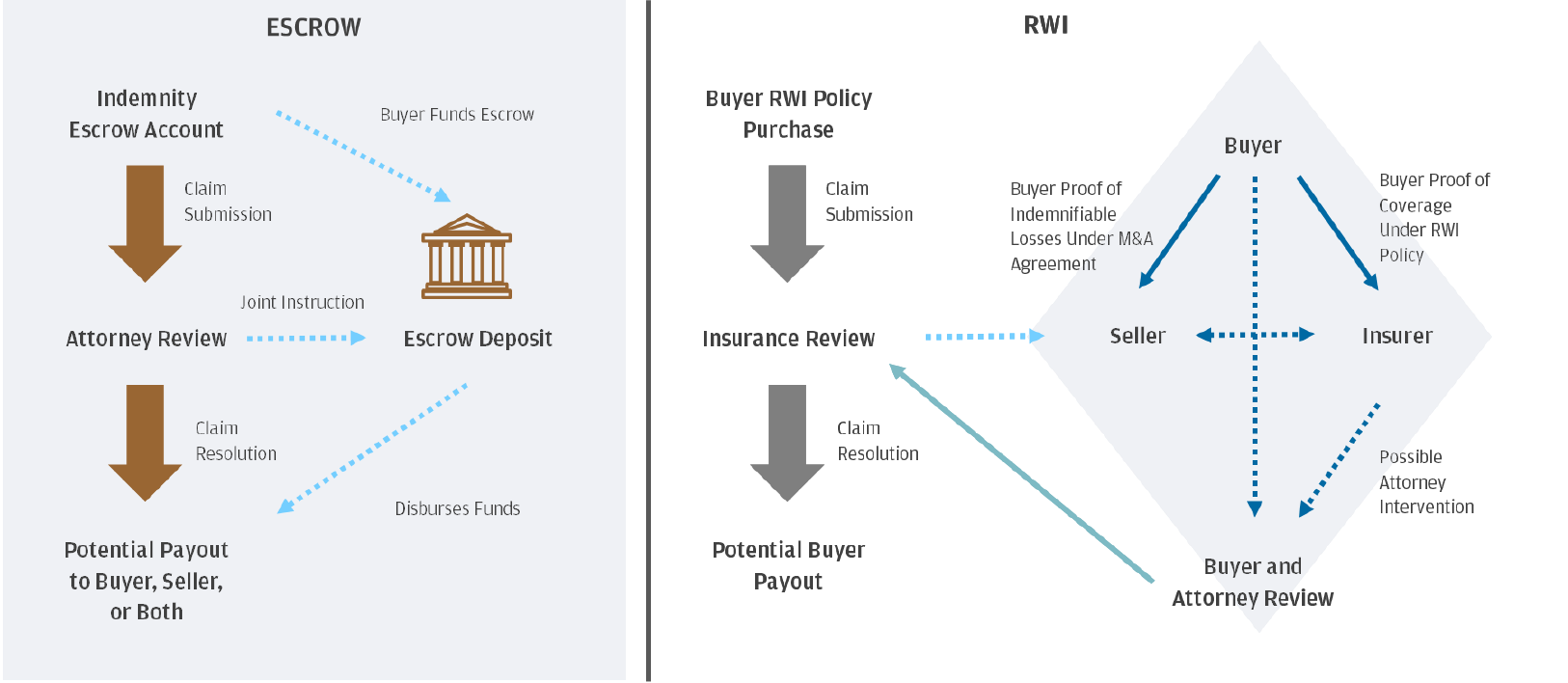
INTRODUCTION
While employee benefits and executive compensation issues rarely drive a transaction, one issue that should be discussed at the beginning of every deal is whether there are any payments that could trigger taxation under Section 280G.[1] Ignoring this Code section or waiting until a few days before closing to address potential Section 280G issues could result in a large tax bill for impacted individuals, as well as a loss of deduction for the corporations involved and angry clients and executives.
Section 280G and its counterpart, Section 4999, were enacted by Congress in 1984 to address Congressional concerns and the then-common belief that corporate executives were receiving financial windfalls in the deluge of mergers and acquisitions occurring in the ‘80s, which in turn was impacting shareholder value and potentially could have a cooling effect on M&A activity. As with many provisions of the United States Tax Code, Section 280G and its counterpart Section 4999 attempt to curtail behavior by (i) imposing an excise tax on certain compensation received in connection with the change of control by the executives under Section 4999; and (ii) causing the corporation to lose its deduction under Section 280G for any compensation that subject to such taxation. While the concept of taxation and loss of deduction sounds simple, the application creates a web of complexity that requires someone familiar with these rules to navigate its application in corporation transactions. This article endeavors to assist practitioners unfamiliar with this area in identifying issues in transactions by providing a brief overview of Section 280G and how it can be avoided or if avoidance is impossible, how to offset it or mitigate its impact.
OVERVIEW OF SECTION 280G
Practitioners often refer to the complications caused by Sections 280G and 4999 simply as “280G,” but as noted above, these are two distinct Code sections that work in tandem to penalize both the impacted individual and the corporation. Section 4999 imposes a 20% excise tax on the disqualified individual (referred to as “disqualified individuals” and discussed more in depth below) payee of an “excess parachute payment.” Section 280G disallows a deduction for the payor of such “excess parachute payment.” The 20% excise tax under Section 4999 and the disallowance of deduction under Section 280G only apply if there is an “excess parachute payment,” and there can only be an “excess” if there is first a “parachute payment.”
Determining whether a parachute payment exists depends upon calculation of the disqualified individual’s “base amount.” In general terms, payments and other benefits provided as a result of a change of control will not be subject to these provisions if they do not equal or exceed three times the disqualified individual’s five-year average compensation (“base amount”) using compensation for the five most recent tax years ending before the change of control. See Treas. Reg. §1.280G-1, Q&A-34. If the disqualified individual receives parachute payments in excess of three times the base amount, a 20% excise tax will apply to any amount paid that is in excess of one times the base amount, and the corporation will lose the corresponding deduction for the amount that is subject to the tax. For example, if the disqualified individual’s five-year average compensation was $500,000, and she received a parachute payment of $2,000,000, the 20% excise tax (and corresponding corporate deduction) would apply to $1,500,000 of the excess parachute payment.
Generally, the disqualified individual’s Form W-2 – Box 1, or for independent contractors or outside directors, Form 1099 – Box 1, is used to determine the compensation for purposes of calculating the base amount. However, if the disqualified individual has not performed services for the entire five-year period, his or her total employment period during such five-year period will be included with compensation for any partial year being annualized. Treas. Reg. §1.280G-1, Q&A-35. If the disqualified individual was hired in the year of the change of control (and had no other compensation from the corporation during the five prior taxable years), generally the individual’s base amount will be his or her annualized compensation that was includible in his or her gross income for the period prior to the change of control that was not contingent on the change of control. Treas. Reg. §1.280G-1, Q&A-36. Also, benefits provided to a disqualified individual which have not yet become taxable, such as unexercised stock options or deferred compensation, will have a direct impact on this calculation. If a disqualified individual earns $500,000 a year, and exercised stock options in the year prior to the change of control resulting in additional compensation income of $1,000,000, that disqualified individual’s base amount will be increased by $200,000 (assuming he has worked for the corporation for at least five years).
Further, if the disqualified individual has changed positions during the five-year period, for instance from outside director to CEO, the base amount may be artificially low. For example, assume an outside director has been receiving director fees of $50,000 per year for the past five years, and then is promoted to the position of CEO with compensation of $1,000,000 in January of 2020 and then a change of control occurs in July of 2020. The base amount for this newly-appointed CEO will be three times the average base compensation he received as a director (3 x $50,000) and would not even consider his compensation as CEO.
It is also important to remember that Sections 280G and 4999 apply to both public and private corporations. The term “corporations” for purposes of these Code sections includes publicly-traded partnerships, Section 854(a) real estate investment trusts, mutual or cooperative corporations, foreign corporations and tax-exempt Section 502(a) corporations. Generally, payments made by partnerships, limited liability companies taxed as partnerships, S corporations, and corporations that could elect to be S corporations (even if they have not done so) are not subject to Sections 280G and 4999. Treas. Reg. §1.280G-1, Q&A-6. However, if an entity is part of an affiliated group that includes a corporation, there may be issues under Sections 280G and 4999 even if the actual payor of the compensation is an entity not otherwise subject to these provisions. Parties in transactions that include affiliated groups should make sure that counsel familiar with these sections advises on the transaction.
Practitioners also should tread carefully if non-U.S. entities are involved in the transaction. There is no specific exemption from Section 280G for non-U.S. corporations. It is possible for the sale of a foreign subsidiary of a U.S. corporation parent to trigger a change of control for Section 280G, or vice versa.
Who Is a “Disqualified Individual”?
There is a common misconception that Section 280G only applies to “executives,” but in reality, Section 280G can potentially impact non-executive level employees, consultants, directors and shareholders. A disqualified individual includes any individual (employee or independent contractor) who is an officer, shareholder, or highly-compensated individual with respect to the corporation. Section 280G(c); Treas. Reg. § 1.280G-1, Q&A-15(a). Additionally, directors are considered disqualified individuals if the director is also a shareholder, officer, or highly-compensated individual with respect to the corporation. Treas. Reg. § 1.280G-1, Q&A-15(b). While an individual may fall within more than one of these categories, all that is required is that the individual fall into one of these three categories within the 12-month period immediately prior to the change of control, and as a result, even former service providers could have concerns under these sections. For example, an individual who terminated employment six-months prior to the change of control, and was a 1% shareholder, would be treated as a disqualified individual for purposes of the change of control. Personal service corporations providing services to the corporation are also treated as “individuals” when determining who is a disqualified individual. Treas. Reg. §1.280G-1, Q&A-16. The fact that a consultant has used his or her own single-member limited liability company to provide services to the corporation does not avoid the tendons of Sections 280G and 4999.
Highly-compensated individuals are persons within the lesser of (i) the highest paid 250 employees; or (ii) the highest paid 1% of employees of the corporation. Treas. Reg. § 1.280G-1, Q&A-19. A shareholder, for these purposes, is only considered a disqualified individual if the shareholder provides services to the corporation (either as an employee or independent contractor, including outside directors) and owns more than 1% of the fair market value of the outstanding shares of all classes of the corporation’s stock. In determining stock ownership, the attribution rules of Section 318(a) apply. Stock underlying a vested option is considered owned by the individual who owns the vested option (and stock underlying an unvested option is not considered owned by the holder of the unvested option). If an unvested option to purchase a corporation’s stock automatically vests upon a change of control, the stock underlying such option is considered owned by the holder of the option for purposes of these rules. Treas. Reg. § 1.280G-1, Q&A-17.
The determination of whether an individual is an officer is based on the facts and circumstances in each particular case (such as the source of the individual’s authority, the term for which the individual is elected or appointed, and the nature and extent of the individual’s duties). Treas. Reg. §1.280G-1 Q&A-18(a). Generally, the term “officer” means an administrative executive who is in regular and continued service. Any individual who has the title of officer is presumed to be an officer unless the facts and circumstances demonstrate that the individual does not have the authority of an officer. However, an individual who does not have the title of officer may nevertheless be considered an officer if the facts and circumstances demonstrate that the individual has the authority of an officer. The term “officer” includes individuals who are officers with respect to other members of the acquired corporation’s controlled group. Treas. Reg. §1.280G-1 Q&A-18(b). Treasury Regulations limit the number of employees of the corporation and its controlled group that can be treated as disqualified individuals solely by reason of being an “officer” to the lesser of (i) 50 employees; or (ii) the greater of 3 employees or 10% of employees of the controlled group, rounded up to the nearest integer. Treas. Reg. §1.280G-1 Q&A-18(c).
What Is a “Parachute Payment”?
Under Section 280G(b)(2), a parachute payment is any payment in the nature of compensation to (or for the benefit of) a “disqualified individual” if (i) the payment is contingent on a change of the ownership or effective control of the corporation or in the ownership of a substantial portion of the assets of the corporation; and (ii) the aggregate present value of the payments in the nature of compensation which are contingent on such change equals or exceeds three times the individual’s base amount. Section 280(G)(2)(b).
Virtually all payments of cash or valuable property to an employee or independent contractor will be considered to be in the nature of compensation, including bonuses, severance pay, fringe benefits, pension benefits, and other deferred compensation. Treas. Reg. § 1.280G-1, Q&A-11. More difficult questions arise in the categorization of items such as stock options, restricted stock, and other benefits subject to vesting or forfeiture, particularly the determination of when a payment has been made and whether a payment is contingent upon a change of control. Property transferred in connection with services is generally subject to taxation under Section 83, and becomes taxable when it is transferred if it is substantially vested and has an ascertainable value. However, if the property is subject to forfeiture at the time of transfer or does not have a readily ascertainable value, taxation will occur at a later date. If property previously transferred to a disqualified individual becomes vested as a result of the change of control, it will be included in the parachute payment computation unless exempt as reasonable compensation for services rendered before the date of the change of control. Treas. Reg. § 1.280G‑1, Q&A-12. This result applies even if the disqualified individual made a Section 83(b) election to tax the property as compensation income at the time it was actually transferred to him. Treas. Reg. §1.280G-1, Q&A-34(d).
A special rule applies with respect to non-qualified stock options. Under Q&A-13 of the regulations, an option is treated as a payment in the nature of compensation at the time the option vests (regarding of whether the option has a readily ascertainable fair market value as defined in Treas. Reg. § 1.83-7(b)). Treas. Reg. §1.280G-1, Q&A-13. If an option is fully vested and also has an ascertainable value prior to the change of control, it will not be considered in the calculation of the parachute payment; similarly, if the option would become substantially vested without regard to the change of control and its value is ascertainable, it would not be included in the calculation. For parachute payment purposes, an option which vests upon a change of control is valued on the basis of all facts and circumstances, including the option spread at that time, the probability that the spread will increase or decrease, and the length of the option exercise period. Valuation of such options may be challenging, especially when a disqualified individual’s employment agreement or severance agreement contains a golden parachute cap which is intended to limit the amount of “compensation” he receives as a result of a change of control. (See the discussion below regarding cut-backs).
Practitioners should continue to ask the parties to the transaction whether there are any new payments being made to any service provider throughout the transaction until to the closing. A client may advise at the beginning of a transaction that it has none of the payments that would be treated as parachute payments, but as the transaction progresses, decide to pay large change of control bonuses to employees. Even a small bonus could create a Section 280G issue when added to already existing parachute payments.
What Transactions Trigger Section 280G?
The term “change of control” can have many meanings, both under the law, and in written agreements between the parties. In any corporate transaction, it is important to review all change of control definitions in the various agreements to determine whether the proposed transaction would actually constitute a change of control for purposes of the agreements. In addition, it is important to determine whether the transaction would constitute a “change of control” for purposes of Section 280G (because in some cases, what is a change of control under a written agreement may not be a change of control under Section 280G and vice versa).
“Change of control” is not specifically defined in the statute, other than to provide that transactions that are a change in the “ownership or effective control of the corporation” or “in the ownership of a substantial portion of the assets of the corporation” would constitute a change of control. See Section 280G(b)(2)(A)(i). The Treasury Regulations, specifically, Q&A-27, do provide some guidance regarding what constitutes a change of control. Generally, a change of control occurs under Section 280G on the date that any one person, or more than one person acting as a group, acquires ownership of stock of the corporation that, has more than 50% of the total fair market value or total voting power of the stock of such corporation, referred to as a change in the ownership of a corporation. However, a change of control also is presumed to occur if there is a change in the effective control of the corporation, which means that there has been either (i) an acquisition of 20% or more of the total voting power of the corporation by any person or group; or (ii) the replacement of a majority of the board members of the corporation (other than the directors whose appointment is approved by a majority of the current board). This presumption may be rebutted if the parties can establish that the acquisition of stock or replacement of a majority of the board did not result in a transfer of power to control (directly or indirectly) the management and policies of the corporation from any one person (or more than one person acting as a group) to another person (or group). See Treas. Reg. §1.280G-1, Q&A-28. Further, a change in the effective control does not occur if the changes do not occur within a 12-month period (for instance, a person could not purchase 10% of the stock in three separate years and trigger a change of control).
Finally, a change of control occurs when there is a change in the ownership of a substantial portion of the corporation’s assets. A “substantial portion” means assets having a total gross fair market value equal to or more than one-third of the total gross fair market value of all of the assets of the corporation immediately prior to the acquisition. Treas. Reg. §1.280G-1, Q&A-29. A transfer of assets will not be treated as a change of control for Section 280G purposes if the assets are transferred to (i) a current shareholder of the corporation in exchange for or with respect to its stock; (ii) an entity if 50% or more of the voting power is owned (directly or indirectly) by the impacted corporation; (iii) a person that owns 50% or more of the total voting power of all the outstanding stock of the impacted corporation; or (iv) any entity for which 50% or more of the total value or voting power is owned by any of the entities described in (i), (ii) or (iii).
When analyzing whether a change of control has occurred in a controlled group of corporations, it generally must be a change of control of the parent entity. The sale of a subsidiary of the parent would not trigger a change of control unless the subsidiary’s assets equal more than one-third of the parent’s assets. It is important to identify which entity is undergoing the change of control so that the proper analysis can be completed for Section 280G purposes.
What Is an “Excess Parachute Payment”?
Loss of deductibility and application of the excise tax only apply to the “excess parachute payment.” Once it has been determined that there is a parachute payment (that the payments contingent on change of control exceed three times the base amount), the excess of such contingent payments over one times the base amount will be considered the “excess parachute payment” to which the excise tax and loss of deduction apply. In other words, going one dollar over the three times base amount threshold results in the entire amount of the contingent payments, reduced only by one times the base amount, being subject to these tax provisions.
What Payments Are Contingent on a Change of Control?
As noted previously, the payments must not only be in the nature of compensation, but also must be contingent on the change of control. Most executive employment agreements and compensation plans (i.e., severance agreements, bonus plans, nonqualified deferred compensation plans, stock option plans) contain change of control provisions that will most likely be triggered by a merger, asset sale or stock sale, resulting in bonus payments, higher severance payments and acceleration of equity in connection with the transaction. These types of payments, that clearly are triggered on the change of control, are easy to identify, but rarely are the only payments that are treated as contingent on a change of control.
Whether a payment is contingent on a change of control is generally determined under a “but for” test. To exclude the payment, it must be substantially certain, at the time of the change, that the payment would have been made whether or not the change occurred. Acceleration of vesting or acceleration of the time for payment will cause the payment to be treated as contingent upon the change, at least to some extent. Treas. Reg. §1.280G-1, Q&A-29. The portion of the payment treated as contingent is the amount by which the payment exceeds the present value of the payment absent the acceleration. Treas. Reg. §1.280G-1, Q&A-24. However, if the payment of deferred compensation was not vested (for example, it would have been forfeited had the disqualified individual terminated employment prior to age 65), the entire amount of the payment will be included in the computation if the change results in substantial vesting.
If a payment is merely accelerated by a change of control, it will not be treated as contingent upon the change of control if the acceleration does not increase the present value of the payment. These calculations are complicated if the payment that is accelerated would have been paid without regard to the change so long as the individual continued to perform services for a specified period of time. In that event, the value of the acceleration will take into account not only the value provided to the disqualified individual by earlier payment, but also the value added by elimination of the risk of forfeiture for failure to continue to perform services. If the disqualified individual and the employer are unable to establish a reasonably ascertainable value for both of these elements, then the entire amount of the accelerated payment will be included in the computation. This typically occurs with respect to performance-based bonuses or awards that are accelerated and vested upon the change of control regardless of whether the performance criteria have been achieved, in which case the entire amount of the payment would be treated as the parachute payment.
The present value of a payment which is to be made in the future is determined as of the date on which the change of control occurs, or on the date of payment if the payment is made before the change of control. First, the payment is discounted at a rate equal to 120% of the applicable federal rate. Treas. Reg. §1.280G-1, Q&A-32. Secondly, if the payment is contingent on an uncertain future event or condition, then the likelihood of whether the payment will be made must be reasonably estimated. If it is reasonably estimated that there is a 50% or greater probability that the payment will be made, then the full amount of the payment is considered for purposes of the 3-times the base amount test and the allocation of the base amount. Treas. Reg. §1.280G-1, Q&A-33. If it is reasonably estimated that there is a less than 50% probability that the payment will be made, the payment is not considered for either of these purposes. If the likelihood estimate is later determined to be incorrect, the 3-times the base amount test must be reapplied (and the portion of the base amount allocated to previous payments must be reallocated (if necessary) to such payments) to reflect the actual timing and amount of the payment.
For example, if a disqualified individual will be entitled to payment of $1,000,000 in the event his employment is terminated within one year after a change of control, and the corporation reasonably estimates that there is a 50% probability the disqualified individual’s employment will be terminated within one year, then the entire payment would be considered. If the timing of the payment can also be reasonably estimated, an additional discount may be applied. The determination of the likelihood of an event occurring can be made as late as the date the corporation files its income tax return for the year in which the change of control occurs. For example, if a change of control occurs on June 1 and the corporation files its income tax return in April of the following year, the corporation can look back and determine whether or not the event has occurred or has become likely to occur.
AVOIDING, OFFSETTING AND MITIGATING THE IMPACT OF SECTION 280G
Once the parties have identified that there are payments that may trigger taxation under Sections 280G and 4999, the next step is to outline those potential payments and determine whether there is any way to avoid, offset or mitigate the potential impact of these sections. It is important to note that while legal counsel can certainly run some initial calculations, most often an accounting firm is charged with running the final calculations that will be relied upon for analyzing the Section 280G issues, withholding taxes, and filing returns.
There are three primary approaches to avoiding, mitigating or offsetting Section 280G liability: (i) if it is a non-public corporation, relying upon the shareholder vote exception; (ii) reducing the amounts payable to the disqualified individual to one dollar less than the amount that would trigger the excise tax (called a “cut-back”); or (iii) “grossing-up” the payments so that the disqualified individual receives the same amount after application of the excise tax under Section 4999 as he or she would have received had Section 4999 not applied.
Law firms often work closely with the accounting firms and clients to determine the best approach to avoid, mitigate, or offset Section 280G liability. The law firms also will draft the documents outlined below (whether it be the documents for the shareholder vote, cut-back, or gross-up language for agreements with the disqualified individuals). Both counsel for the buyer and the seller will review these documents, so practitioners should focus on getting documents drafted with enough time for both sides to review and provide comments. This process is generally collegial when both law firms handle a high volume of deals but becomes more challenging when one side’s counsel is unfamiliar with Section 280G or does not have executive compensation counsel assisting with the transaction.
Private Companies with Shareholder Vote
As noted earlier, part of the reason Section 280G and 4999 were adopted was to protect shareholders from executives diverting value from shareholders and into their own pockets. Since shareholder protection was one of the primary goals, if the shareholders do not have an issue with the payments, then there is no reason for the taxes to apply. Congress included the shareholder vote exception in Section 280G for this exact reason. Under this exception, payments with respect to a change in ownership of a private company are not treated as parachute payments if the payments are approved by 75% of the shareholders entitled to vote immediately before the change in ownership, after adequate disclosure to all shareholders entitled to vote. Section 280G(b)(5) and Treas. Reg. §1.280G-1, Q&A 6 and Q&A 7. For these purposes, shareholder approval can be retroactively obtained. In order to rely on this exception, neither the company undergoing the change of control nor any members of its controlled group can be publicly-traded.
The shareholder population means the shareholders of record, as determined no more than six months before the date of the change in ownership or control. If a substantial portion of the assets of an “entity shareholder” (within the meaning of Treas. Reg. § 1.280G-1, Q&A-7(b)(3)) consists (directly or indirectly) of stock in the corporation undergoing the change in control (i.e., the total fair market value of the stock held by the “entity shareholder” in the corporation undergoing the change in control equals or exceeds one-third of the total gross fair market value of all of the assets of the “entity shareholder” without regard to any liabilities associated with such assets), approval of the payment by that “entity shareholder” must be made by a separate vote of the persons who hold, immediately before the change in control, more than 75% of the voting power of the “entity shareholder” (unless the entity shareholder owns, directly or indirectly, 1% or less of the total value of the corporation undergoing the change in control). Shares owned (directly or constructively) by a person who is to receive a payment that would be a parachute payment if shareholder approval is not obtained are not eligible to vote (and are not counted as outstanding for purposes of the vote). As a practical matter, practitioners may find it challenging to determine whether a shareholder constructively owns shares, making it crucial that parties start evaluating this issue as soon as the disqualified individuals are identified.
In order for the disclosure to the shareholders to be adequate, the “disclosure must be full and truthful disclosure of the material facts and such additional information as is necessary to make the disclosure not materially misleading at the time the disclosure is made.” Treas. Reg. §1.280G-1, Q&A 7(c). The description needs to include: (i) a description of the event triggering the payment(s); (ii) the total amount of the payment(s) that would be parachute payment(s) if the shareholder approval requirements are not satisfied; and (iii) a brief description of the payment(s) (e.g., accelerated vesting of options, bonus, or salary). The disclosure should give information on the effect of approval or disapproval. In addition, the disclosure must be delivered to all shareholders, not just the 75% needed to approve the payments.
The shareholder vote must be meaningful, which means that the amounts being approved must be at risk. Typically, if the disqualified individual has an existing contractual right to the payment being approved, the individual will be asked to sign a waiver agreement prior to the shareholder vote. The waiver agreement will provide that if the shareholders do not approve the payments, then any payments in the nature of compensation being paid in connection with the change of control will be reduced to one dollar less than the amount that would otherwise trigger the excise tax. Further, the shareholder vote must be independent of the shareholders vote on the underlying transaction. It is not permissible to include as a closing condition to the transaction that the shareholders have approved the payments. The only requirement that can be included in the purchase agreement is that the seller provide evidence that they conducted the shareholder vote in accordance with the requirements of Section 280G.
If the seller is owned by a small number of shareholders or only a handful of shareholders own the required 75% of the vote needed and the shareholders are supportive of the executive team, obtaining the shareholder vote tends to be a rather routine part of the deal that merely requires deal counsel to get the proper disclosures, waivers and resolutions timely drafted and submitted to the shareholders. However, if there are a large number of shareholders or the shareholders have an adversarial relationship with management, the shareholder approval approach may not work. In such cases, the parties need to look at potentially cut-back the payments or grossing up the payments as discussed below.
Cut-backs, Gross-Ups and Best Net Clauses
For public corporations, or private corporations where the shareholder vote is not a viable alternative, the parties have two primary options to address Section 280G issues: (i) cut-back the payments so that Section 280G and the taxes under Section 4999 are not triggered; or (ii) gross-up the payments. Before deciding on which approach to use, practitioners should first review the relevant agreements to determine whether Section 280G was addressed in the contract when signed. Often employment agreements and severance agreements will include paragraphs that specifically address how the compensation will be treated under Section 280G in the event of a change of control. If the parties want to take an approach that differs from the underlying agreements, the disqualified individual subject to the agreements will need to consent to the new approach. The disqualified individual’s consent may not be easy to obtain if the disqualified individual will receive less compensation under the new approach.
Cut-back. If the parties elect to use the cut-back approach, the disqualified individual’s parachute payments are reduced to an amount that is one dollar less than the amount that would trigger the 20% excise tax. A disqualified individual without a gross-up agreement may prefer to have his or her payments capped if it appears likely that he or she will be close to the three times base amount threshold or just over that threshold. For example, a disqualified individual with a base amount of $300,000 could receive contingent payments of up to $899,999 without being subject to the 20% excise tax. However, if that disqualified individual receives contingent payments of $900,001, he or she would be subject to an excise tax of $120,000 ($600,001 times 20%). By agreeing to give up $2, the disqualified individual saves $120,000. However, if that same individual was entitled to contingent payments of $1,100,000, the excise tax would be $160,000 (an excess parachute payment of $800,000 multiplied by 20%), and the disqualified individual would receive $40,000 more by taking the payment rather than having it capped. The corporation will generally prefer to cap the benefits, because going over the three times base amount threshold by $1 results in loss of the deduction for the entire amount of the excess parachute payment. However, if capping or cutting back the compensation would result in payments being less than the disqualified individual would receive if the full amount was paid and the 20% tax was applied, he or she may not be willing to agree to a cut back.
Gross-up. Even if the amount would not be less under the cut-back, the disqualified individual may feel like the corporation is breaking its promise to the individual of a certain amount of compensation in the transaction, and that the corporation should have warned the individual at the time the promise to pay the compensation was made that the amount might be substantially less because of Section 4999. In such cases, the parties may consider adding a gross-up so that once the taxes under Section 4999 are deducted, the disqualified individual receives the same amount he would have received had the excise tax not applied. If the disqualified individual is provided a full gross-up, the cost to the employer can be significant, because not only will the initial 20% excise tax be paid by the corporation (and non-deductible), but also all income tax and additional excise taxes applicable to the gross-up amount must also be paid. Because of this increased cost to the employer, gross-up clauses have been attacked as excessive pay practices by Institutional Shareholder Services and other similar institutional shareholder watch-dog organizations. If either corporation in the transaction is a publicly-held corporation that has a large percentage of shareholders following ISS or other such organizations, use of a gross up can result in significant shareholder backlash, and potentially a “no” vote recommendation on other matters.
Best net. A third option, which is often used by publicly-held corporations, is to apply a “best net” approach to the payment. Under the best net approach, the disqualified individual receives the greater of the (i) full amount of the payments, less the 20% excise tax; or (ii) one dollar less than the amount that would trigger the 20% excise tax. This approach could still result in a loss of deduction for the corporation if the greater amount is the full amount of the payment less the excise tax, but many corporations still agree to this approach because it is better than a gross up and usually satisfies the disqualified individual once the individual understands the potential backlash causes by a gross up payment.
It is not often easy to determine whether a disqualified individual will be close to his or her threshold amount, significantly under it, or significantly over it. Questions may arise about inclusion of certain benefits and payments in the calculation of the base amount. Moreover, as noted above, calculation of the present value of future contingent payments may be quite difficult and subject to adjustment based upon later events, and treatment of particular payments as contingent on a change of control may not be certain. If this issue is addressed sufficiently far in advance of the effective date of the change of control, each disqualified individual can review his or her own situation and work with the buyer and seller on the best approach for all parties.
Reasonable Compensation
If it has already been determined that a disqualified individual has an excess parachute payment, the amount of that excess parachute payment may be reduced by the portion of the payment that the disqualified individual establishes by clear and convincing evidence is reasonable compensation for services prior to or after the change of control. Treas. Reg. §1.280G-1, Q&A 3, 9, 24(a)(2) and 39.
Only payments that can be established by “clear and convincing evidence” to be reasonable compensation for services rendered are not treated as parachute payments. Section 280G(b)(5) and Treas. Reg. § 1.280G-1, Q&A-6 and Q&A-9. The determination of whether a payment is “reasonable” is based on the facts and circumstances relating to each payment and each disqualified individual. Treas. Reg. §1.280G-1 Q&A 40. The regulations issued under Section 280G provide that the relevant factors to the determination of whether a payment is reasonable compensation include, but are not limited to, (i) the nature of the services rendered or to be rendered; (ii) the individual’s historic compensation for performing such services; and (iii) the compensation of individuals performing comparable services in situations where the compensation is not contingent on a change of control. Treas. Reg. § 1.280G-1, Q&A-40(a).
All payments in connection with a change of control are presumed unreasonable. For purposes of determining whether a payment is contingent on a change of control, there is a presumption that any payment that is made within the period beginning one year before and ending one year after the date of the change in ownership or control is made in connection with the change of control. Treas. Reg. §1.280G-1, Q&A-22(b)(3). Conversely, there is a presumption that any payment made outside of this two-year time period is not made in connection with a change of control.
There also is a distinction between the treatment of compensation for services rendered before the change of control and compensation for services rendered on or after the change of control. Payments of compensation that were clearly earned before the change of control generally are considered reasonable compensation for personal services actually rendered before the change of control if the payments qualified as reasonable compensation under Section 162. Treas. Reg. §1.280G-1, Q&A-43. Examples of payments that are commonly treated as payments for services rendered include bonuses paid in the ordinary course in accordance with the corporation’s bonus plan in the year prior to the change of control, or pro rata bonuses paid to an employee prior to the change of control based on actual performance. The Treasury Regulations also provide that a showing that payments are made under a nondiscriminatory employee plan or program generally is considered to be clear and convincing evidence that the payments are reasonable compensation. Treas. Reg. § 1.280G-1, Q&A-26. Examples of nondiscriminatory employee plans include group term life instance, cafeteria plans, and educational assistance plans.
However, new programs or increases in base salary that occur within the one-year period prior to a change of control can be problematic. The parties to the transaction should use care to support any large increase or adoption of new programs with market data and other objective evidence to show it is comparable to other peer group members when trying to argue it is reasonable compensation.
Payments for services rendered within the one-year period prior to the change of control are considered “parachute payments,” but are not considered “excess parachute payments” to the extent they are reasonable compensation. Section 280G(b)(4)(B) and Tress. Reg. §1.280G-1, Q&A-3. Thus, payments for services rendered in the one-year period before a change of control (i) are included for purposes of determining whether all payments received in connection with a change of control exceed the three times base amount threshold; but (ii) are exempt from the 20% excise tax; and (iii) may be deducted by the payor. Again, the burden is on the corporation to establish by clear and convincing evidence that these payments are reasonable compensation for services rendered prior to the change of control.
If payments are received for services rendered on or after the change of control (e.g., continued salary, post-transaction consulting arrangements, bonuses for performance periods after the change of control) or pursuant to an agreement entered into after the change of control, they generally are not considered “parachute payments,” and thus are excluded from the determination of whether all payments in connection with a change of control exceed the three times base amount threshold. Section 280G(b)(4)(A) and Treas. Reg. §1.280-1, Q&A-9 and Q&A-23. One exception to this general rule is if the payments are made pursuant to an agreement that is executed after a change in ownership or control pursuant to a legally enforceable agreement that was entered into before the change, in which case, the agreement is considered to have been entered into before the change. Treas. Reg. §1.280-1 Q&A 25. For instance, if the purchase agreement requires the buyer to provide retention bonuses to the seller’s employees that it hires, and the buyer enters into those agreement post-closing, the agreement would be treated as entered into prior to the change of control. In addition, if the disqualified individual post-closing gives up a right made under an agreement that was entered into prior to the change of control in exchange for benefits under a post-closing agreement, the new agreement will only be treated as a post-closing agreement to the extent the value exceeds the value of the payments under the pre-closing agreement. Treas. Reg. §1.280-1 Q&A 25.
In the event the agreement entered into prior to the change of control includes severance payable after the change of control and a non-compete provision, the parties may be able to argue that some portion of the severance is reasonable compensation as a payment made in exchange for a covenant not to compete. Under the Treasury Regulations, payments that can be established to be made in exchange for a covenant not to compete are reasonable compensation for services to be rendered on or after the change of control. Treas. Reg. §1.280G-1, Q&A-40(b) and PLR 9314034 (1/8/1993). However, this does not mean that the entire amount of the payment that is linked to the non-compete is automatically excluded. The non-compete must be enforceable, which means it must be both enforceable in the jurisdiction where it applies, and the corporation must not have a history of waiving non-competes. If the corporation never enforces non-competes, then the payments will not be deemed reasonable compensation. Further, the parties must consider the amount of damage the disqualified individual may inflict on the business if he or she competes. This value might be different for each disqualified individual, and likely has a higher value for someone in his or her 40s versus an 80-year-old disqualified individual who intends to retire after the transaction. Typically, accounting firms value the non-compete and determine what, if any, value can be treated as reasonable compensation. It is important to make sure both the seller and the buyer agree to the value. If the buyer does not agree with the value and determines later when taking the deduction that the assigned value was too aggressive, it could result in an increase in the parachute payments and tax liability for the disqualified individuals after the transaction closes.
Conclusion
Navigating the issues raised by Section 280G and 4999 can be complicated. However, if issues are addressed early in the transaction, then all parties involved can better understand the impact of the excise taxes, or the actions the parties need to take in order to mitigate or offset the impact of these sections. With time, and careful planning, the parties can avoid the pitfalls outlined above, and prevent these sections from unduly burdening a transaction.
[1] All references to Section mean a section of the U.S. Internal Revenue Code of 1986, as amended.












